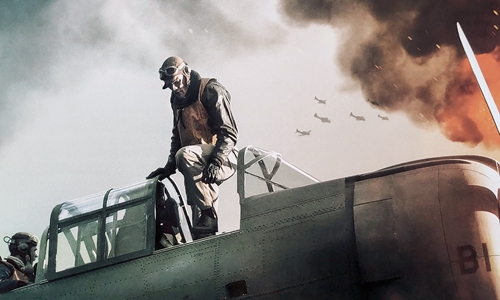HOME >> ARTS
Roland Emmerich’s war epic ‘Midway’ fails to rouse Chinese audiences
By Tao Mingyang Source:Global Times Published: 2019/11/18 17:52:44

Promotional material for Midway Photo: IC
Roland Emmerich, film director of box-office hits such as The Day After Tomorrow, 2012, and the Independence Day films, released his latest movie Midway in the Chinese mainland on November 8.
However, its performance in the Chinese mainland has not lived up to expectations, leaving people wondering whether this Hollywood war film will be able to make enough in the country to put a dent in its reported $70-$100 million budget.
Midway recreates a key battle in the Pacific during World War II. The film has a 43 percent freshness rating on Rotten Tomatoes, a 6.2/10 on IMDB and a 7.7 on Chinese media review site Douban.
However, nearly 70 percent of audiences on Douban have given it four to five stars out of five, which dovetails with the 92 percent audience score the film has on Rotten Tomatoes. It's obvious Midway is being looked upon more favorably by filmgoers than movie critics.
Although Chinese audiences have said they enjoyed the film, it has only earned 197 million yuan ($28.1 million) since it first opened 10 days ago.
On social media, discussions about the film have been overshadowed by competing films such as Chinese movie Better Days and Japanese animation Weathering with You.
Many reviews on Douban say the film's main weakness is the storyline, which compared with World War II films such as Saving Private Ryan, Dunkirk and Hacksaw Ridge lacks human emotion.
"The film was just a repeat of history that you're already familiar with, but leaves you with nothing to remember," reads one review on Douban.
"Emmerich has never escaped from his reputation as a 'famous disaster director' and used too many cheap CG and visual effects due to its low budget," reads another.
The film clearly explains the lead up to the battle between the US and Japan, tracing back to the attack on Pearl Harbor, and the preparations and smaller skirmishes that transpired before the final battle.
Most netizens who responded positively said the film helped them understand the context in which the battle took place.
Battleships and warplanes such as the US' SBD Dauntless and USS Enterprise and Japan's Mitsubishi A6M Zero and the Yamato were carefully restored to keep with historical accuracy.
The film also introduces what was known as the "dive-bomb" strategy, where a bomber would approach a target from a high attitude and suddenly nosedive toward it to drop a bomb.
The war machines combined with the sea warfare scenes have been praised by army and history fans alike.
The film also sheds light on the assistance provided by the Chinese people and army. After a Tokyo raid, US pilot James Doolittle and his team were forced to land at a Chinese airport because they were low on fuel in East China's Zhejiang Province.
The Japanese Army punished the locals who helped Doolittle and killed almost 250,000 Chinese with biological weapons.
However, audiences pointed out that the film shows Doolittle was rescued by Chinese wearing straw hats and who live in a palm forest, which does not exist in Zhejiang Province, but rather has more in common with Vietnam.
Movie critics have noted that it is strange to have such an obvious mistake in a film which pays so much attention to restoring history.
Some Chinese moviegoers have started to compare the film to recent Chinese movies that also tell stories of real events such as My People, My Country, The Captain and The Climbers.
Like My People, My Country, Chinese audiences said Hollywood should make films focusing on individuals taking part in historical events and improve authenticity.
Newspaper headline: Box-office battle
Posted in: FILM,ARTS FOCUS